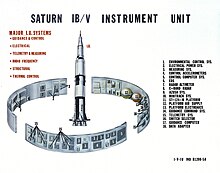Launch Vehicle Digital Computer
The Launch Vehicle Digital Computer ( LVDC ) was the control computer for the Saturn V and Saturn IB rockets . The main task of the LVDC was the flight control of Saturn from take-off until reaching Earth orbit. In addition, he supported functional tests of individual Saturn components before and after the start. It was one of the main components of the so-called instrument unit , an arrangement of devices within a ring-shaped structural component of the rocket, which was arranged between the S-IVB stage (used as the third stage of the Saturn V or second stage of the Saturn IB ) and the respective payload was. The LVDC was developed and built by the IBM Federal Systems Division .
description
hardware
The LVDC worked with a clock frequency of 2.048 MHz (an addition required a time of 82 μs). Its memory - which was designed as a toroidal core memory - had a maximum capacity of 32,768 28-bit data words in memory modules of 4096 data words each. The LVDC worked with 26-bit data words (25- bit data and 1 sign bit) with 2 additional parity bits for error detection. The instructions were 13 bits long with one parity bit. As a result, two instructions fit into one data word, which means that the programs require less memory space, which was advantageous due to the small memory capacity.
For reasons of reliability , the logic of the LVDC was organized in seven levels and designed with triple redundancy at each level with a downstream voting system. This meant that one of three logic modules could fail on each of the seven levels and the LVDC would still produce a correct result. This gave the LVDC an expected reliability of 99.6% over 250 hours of operation.
The LVDC was 74 cm × 32 cm × 27 cm in size, weighed 35 kg and had a power consumption of 137 W.
software
The 13-bit software instructions of the LVDC consisted of a 4-bit operator and a 4-bit address field . This made 16 different instructions possible. But since there were 18 instructions, three instructions used the same operator and two bits of the address field to determine which of the three instructions should be executed.
Web links
- Computers in Spaceflight: The NASA Experience - by James Tomayko (Chapter 7, Part 2, Launch processing in the Saturn era )
- IBM Archives - Saturn Guidance Computer
- IBM Archives - Saturn Instrument Unit

